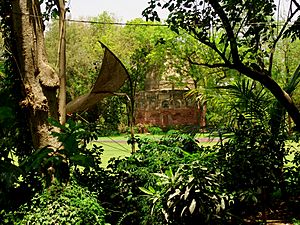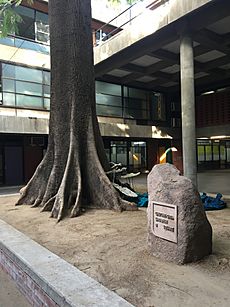National Institute of Design, Ahmedabad facts for kids
| Type | Public |
|---|---|
| Established | 1961 |
|
Academic affiliations
|
|
| Director | Praveen Nahar |
| Undergraduates | ~120 |
| Postgraduates | ~350 |
| 5 (full-time), 8 (part-time) | |
| Location | |
| Campus | Urban |
| Language | English |
The National Institute of Design (NID) is a public design university located in Ahmedabad, India. It also has other campuses in Gandhinagar and Bengaluru. Many people consider NID to be one of the best design schools in Asia. In 2022, it was ranked among the top 51-100 art and design schools worldwide by QS.
NID is an independent institute. It operates under the Department for Promotion of Industry and Internal Trade, which is part of the Ministry of Commerce and Industry in the Government of India. In 2014, NID was given a special status as an Institute of National Importance. This means it's a very important institution for the country.
Contents
History of NID
The idea for NID came about in 1956. The Indian government asked a famous design team, Charles and Ray Eames, for advice. They wrote a document called The India Report. This report suggested creating a design program to help small businesses in India.
Based on their ideas, the government started the National Institute of Design in 1961. It was created as an independent national place for research, service, and training in industrial design and visual communication. The Sarabhai family, especially Gautam Sarabhai and Gira Sarabhai, played a big part in setting up the institute.
Dashrath Patel, a designer and sculptor, was NID's first secretary. H. Kumar Vyas, an industrial designer, was its first full-time professor. Patel worked there until 1981 and received a special award called the Padma Shri. In 2011, Vyas received the Sir Misha Black Medal. This award is given to people worldwide who have greatly helped design education.
Early Collaborations and Growth
The Sarabhai family helped NID grow in its early years. They invited many foreign designers, architects, and artists to India. In the 1950s, Gautam, Gira, and Gita Sarabhai worked with famous designers. These included Frei Otto, Adrian Frutiger, John Cage, and Louis Kahn. They also worked with the Eameses.
NID also hosted important international events. In 1979, it held the United Nation's first global design congress. In 2016, NID and the Indian Institute of Technology Bombay hosted the 'Design for Development' congress. This event followed discussions led by the International Council of Societies of Industrial Design (ICSID) and the United Nations Industrial Development Organization (UNIDO).
NID's Logo and Name
The famous Swiss type-designer Adrian Frutiger created NID's logo in the 1960s. He was visiting NID as a consultant at the time.
The institute had a few different names before settling on its current one. It was first known as the 'National Institute of Industrial Design'. Then it became the 'National Design Institute'. Finally, in the 1970s, it was renamed 'National Institute of Design'.
NID Campuses

NID has its main campus in Ahmedabad. It also has two other campuses, called satellite campuses, in Gandhinagar and Bengaluru.
| Name | Established | State/UT |
|---|---|---|
| Main campus, Ahmedabad | 1961 | Gujarat |
| PG campus, Gandhinagar | 19 July 2004 | Gujarat |
| PG and R&D campus, Bengaluru | 31 March 2006 | Karnataka |
The government suggested creating four more NIDs in 2007. This was part of the National Design Policy.
Main Campus, Ahmedabad
After the Eameses presented The India Report, Gira and Gautam Sarabhai thought Ahmedabad was the best place for the main campus. They chose it because of its architecture and textile industries.
The main campus in Paldi, Ahmedabad, offers both undergraduate (first degree) and postgraduate (advanced degree) courses in many design areas.
Campus Design and Construction
NID first operated out of the Calico Mills complex. This was loaned from the Sarabhai family. Later, it moved to the Sanskar Kendra, a building designed by Le Corbusier. Eventually, Seth Chinubhai Chimanlal offered a large piece of land for the NID campus for a very small fee of one Indian rupee.
The buildings were designed to be simple and practical. Gautam and Gira Sarabhai worked on the building plan. They wanted the architecture, structure, and building methods to work together. They felt the design reflected a modern and functional style.
The main building is built on stilts. The ground floor was for public areas and storage. Workshops and labs were on the first floor. Different workshops for wood, metal, and photography had their own sections. These sections were all connected to the main building. Drafting studios, seminar rooms, and the library were on the second floor. The classrooms are flexible and open. This shows NID's idea of "learning by doing."
PG Campus, Gandhinagar
The 'PG campus' in Gandhinagar is an extension of NID. It was opened in July 2004. This campus mainly offers postgraduate courses in various design fields.
PG and R&D Campus, Bengaluru
Another NID campus was planned for Yeshwantpur, a part of northwestern Bengaluru. This new campus cost about 7.5 crore Indian rupees (about 75 million rupees). It was opened on March 31, 2006.
This 'PG and Research & Development campus' has facilities for industrial development and design research. It offers doctoral (PhD) courses in design. It also has postgraduate courses in many different subjects.

How to Get Admitted to NID
NID is known for having very few spots in its courses. It has a very low acceptance rate, usually around 1%. This means it's quite competitive to get in.
To get into NID, students take the NID Design Aptitude Test (NID-DAT). This is a national-level entrance exam. The NID Admissions Cell organizes it every year. It's for students who want to join undergraduate and postgraduate courses.
The exam has two parts. The first part is NID-DAT Prelims. This is a written test that checks design and general skills. The second part is NID-DAT Mains. This usually involves a design test done in a studio. It might also include a personal interview and a review of the student's portfolio (a collection of their work). These tests check a student's creativity, observation skills, knowledge, and ability to analyze things.
What You Can Study at NID
NID offers a wide range of design courses. These include:
- Graphic design (like designing logos and websites)
- Product design (like designing everyday objects)
- Interior design (like designing spaces inside buildings)
- Filmmaking
- Animation
- Photography
The courses available are:
- Bachelor of Design (B.Des.)
- Graduate Diploma Program in Design (GDPD)
- Master of Design (M.Des.)
- Doctoral programs (PhD) for advanced research.
NID also has international programs and basic foundation courses.
Notable Alumni
Many talented people have studied at NID. Some of them include:
- Dayanita Singh, a photographer and artist
- Lekha Washington, an actress, artist, and product designer
- Harun Robert, an artist and TV personality
- Orijit Sen, a graphic designer
- Aditya Vikram Sengupta, a film director
- Pan Nalin, a filmmaker
- Rahul Mishra, a fashion designer
- Aditya Pande, an artist
- Sujata Keshavan, a graphic designer
- Ishu Patel, a filmmaker
- Nina Sabnani
- Pandu (actor), a comedian
- M. P. Ranjan
Notable Faculty
Some important teachers at NID have been:
- Dashrath Patel
- Helena Perheentupa
- Nina Sabnani
- Nelly Sethna
- Aditi Ranjan
- M. P. Ranjan
See also
- Other National Institutes of Design
- The India Report
- The Sarabhai family
- Calico Museum of Textiles
- Sanskar Kendra
- IIT Bombay IDC School of Design



